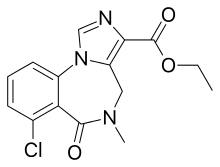Sarmazenil
Sarmazenil (Ro15-3505) is a drug from the benzodiazepine family. It acts as a partial inverse agonist of benzodiazepine receptors,[1] meaning that it causes the opposite effects to most benzodiazepine drugs, and instead acts as an anxiogenic and convulsant. It is used in veterinary medicine to reverse the effects of benzodiazepine sedative drugs in order to rapidly re-awaken anesthetized animals.[2][3][4]
 | |
| Clinical data | |
|---|---|
| AHFS/Drugs.com | International Drug Names |
| ATCvet code | |
| Identifiers | |
IUPAC name
| |
| CAS Number | |
| PubChem CID | |
| ChemSpider | |
| UNII | |
| ChEMBL | |
| CompTox Dashboard (EPA) | |
| Chemical and physical data | |
| Formula | C15H14ClN3O3 |
| Molar mass | 319.743 g/mol g·mol−1 |
| 3D model (JSmol) | |
SMILES
| |
InChI
| |
| | |
References
- López-Romero B; Evrard G; Durant F; Sevrin M; George P (1998). "Molecular structure and stereoelectronic properties of sarmazenil--a weak inverse agonist at the omega modulatory sites (benzodiazepine receptors): comparison with bretazenil and flumazenil". Bioorganic and Medicinal Chemistry. 6 (10): 1745–57. doi:10.1016/S0968-0896(98)00117-5. PMID 9839004.
- Henke J; Roberts U; Otto K; Lendl C; Matis U; Brill T; Erhardt W (1996). "Clinical investigations of an i.m. combination anesthesia with fentanyl / climazolam / xylazine and postoperative i.v. antagonism with naloxone / sarmazenil / yohimbine in guinea pigs". Tierärztliche Praxis (in German). 24 (1): 85–7. PMID 8720962.
- Janovsky M; Tataruch F; Ambuehl M; Giacometti M (2000). "A Zoletil-Rompun mixture as an alternative to the use of opioids for immobilization of feral red deer". Journal of Wildlife Diseases. 36 (4): 663–9. doi:10.7589/0090-3558-36.4.663. PMID 11085427.
- Walzer C; Huber C (2002). "Partial antagonism of tiletamine-zolazepam anesthesia in cheetah". Journal of Wildlife Diseases. 38 (2): 468–72. doi:10.7589/0090-3558-38.2.468. PMID 12038151.
This article is issued from
Wikipedia.
The text is licensed under Creative
Commons - Attribution - Sharealike.
Additional terms may apply for the media files.